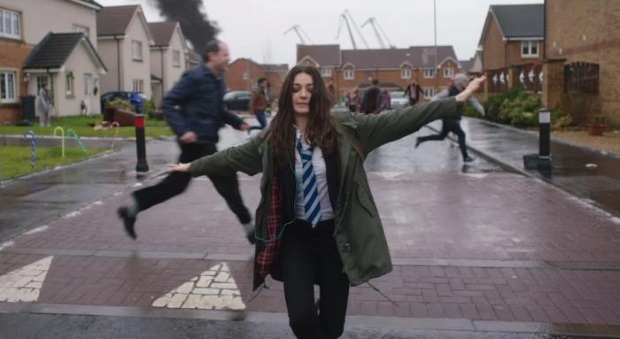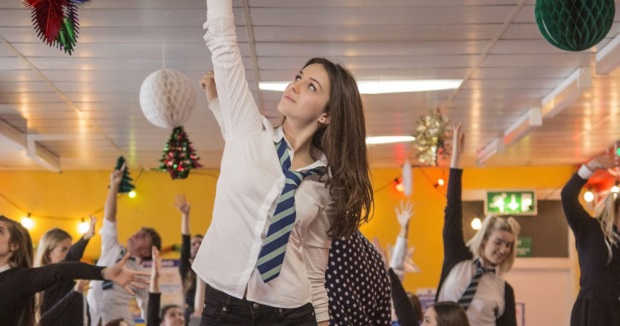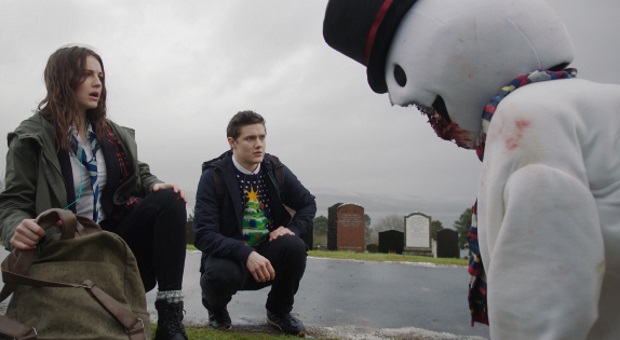Anna And The Apocalypse interview: the director on his zombie musical
Helmer John McPhail reveals the 'incredible journey' of bringing his high-concept genre mash-up to the screen – undead snowmen and all
A high-school musical. With zombies. Set at Christmas. It’s a bold concept for a genre mash-up, but one that Anna And The Apocalypse pulls off with aplomb – thanks to a cool cast, inventive horror set-pieces and some genuinely banging tunes.
The film follows small-town sixth-former Anna (Ella Hunt), bestie John (Malcolm Cumming) and a Breakfast Club-style gang of misfit survivors as they battle their way through a festive invasion of the undead – facing off against school bullies, zombie snowmen and their increasingly insane headteacher (a scenery-munching Paul Kaye) along the way.
Den of Geek sat down with the film’s director, John McPhail, to chat about bringing his bonkers vision to life, hitting the right notes with the musical numbers and the enduring appeal of zombie movies.
Anna And The Apocalypse is quite a unique proposition for a movie project. Can you give us a little bit of the backstory about how it started out?
The project started out in 2012 as a short film, called Zombie Musical. It was written by Ryan McHenry. Ryan was quite a famous young gentleman who did the ‘Ryan Gosling Won’t Eat His Cereal’ Vines. The short won a Scottish new talent Bafta, and then it went into development for the feature film. That’s when my two composers, Roddy Hart and Tommy Reilly, came on board, and then the co-writer, Alan McDonald. The guys were working towards drafting and writing the songs.
And then unfortunately, in 2015, Ryan passed away with osteosarcosis, which is a type of bone cancer. Before he passed, Naysun [Alae-Carew, the film’s producer] asked him if he wanted the project to carry on. He said that he did because there were so many people involved with it. It wasn’t just his film anymore. It was so many other people’s film. They went out and tried to find directors. They were looking at horror directors and musical directors, but just didn’t find that right fit.
My first feature film, Where Do We Go From Here?, is a romantic comedy, a coming-of-age film, about a boy trapped in a care home, but it’s just got big characters and heart. They thought that that might be the right fit for Anna. So I got pitched for the film, and then was lucky enough to get it.
The film’s heart is provided by Anna herself, played by Ella Hunt. Can you tell us a bit about what she’s like, and also what you were looking for when casting the role?
Anna is a high-school girl. She’s about to graduate. She wants to go off and experience a bit of the world before going off to university and that whole cycle begins. You know what happens sometimes: you go to uni, you do your four years, and then you go out and have a job placement, and all of a sudden you’re working.
She’s yearning to get out of this small town and explore the world. And through the duration of the film, she’s just this young girl who’s a little bit lost and trying to find her way. But, like all teenagers, she just doesn’t know what the answer is regarding what she wants to do.
We were trying to find someone who could carry the weight of the role. Ella’s such a wonderful young actress, and she’s so identifiable. She was like that girl next door. We were looking at her to not only carry the character and the story, but also to be that young person we all were when we were teenagers.
She’s just so relatable. And of course, she’s got to do a bit of ass-kicking, as well. There are so many emotions that run through it. You’re going to need a really, really strong actor to play that role.
Ella was just astounding in the casting tape. She was just perfect. We identified her at very, very early doors. When we brought her into the casting, one of the things that I loved about her was that she had questions. She was asking questions about the directions I was giving. “Why, why, why?” I loved that, because I want actors that think for themselves and actors that are going to take that responsibility on about the character.
She’s a thinker. She just wanted to not only get into the role, but to get into Anna’s head. I just loved that about her.

The film has a great sense of inclusivity and positivity. With Anna at the centre, there’s this really cool, funny, nuanced interesting female character, and a lot of her friends are also super-positive. So we’ve got Steph (played by Sarah Swire), who’s gay; we’ve got her best mate, John… Was that aspect a big draw for you?
One-hundred per cent. We live in a melting pot. You walk down the street, and not everybody is going to have the same accent, or going to be same type of person. We wanted each character to feel individual. Even with their voices, we wanted them all to sound different, or to have a different tone of the voice. So even with the musical numbers, you can identify each of them.
One of the things I love about this film is that we have a gay character who nobody talks about being gay. It’s just who she is. She’s part of the world we live in now. Being that inclusive, I think, is really important in film.
That’s not to say it’s like we highlight and talk about it. I feel like that’s when you’re pointing out the problems. As I say, there are so many people that are just different. It’s just part of the world. They don’t have to explain themselves every day. So why should the characters explain themselves?
Absolutely. And there are some lovely scenes between Anna and John, during which you deliberately chose not to use the term “friend zone” at any point…
At one point, we were going to put in the term “friend zone”. But it’s not actually a very good phrase. It puts pressure on young women to go out on dates with people they may not want to because they feel like they’re going to hurt somebody’s feelings. It’s just more pressure. We wanted to be so, so careful about it.
People fall in love with people all the time, or they get infatuations or crushes on folk. But it doesn’t mean that they have to end up being with them.
Anna is her own woman. She is her own girl. And she deserves to be.
So, let’s talk a bit about the songs, which are absolutely banging. At what point did the songs come into the mix?
In the script, there were certain sections where we wanted to drive the story forwards. That was what the songs were always there to do. It’s to drive the story forward and to give us that little bit more behind the characters.
It’s a wonderful way of being able to do that. It’s that exposition. You can sit down, and you can have these characters just pour out all these internal monologues about how they’re feeling and what they want in life. So it was important that we didn’t just go, “Oh, it’s been 15 minutes. Let’s crack a song in there.”
It always has to drive the story. When I came on board, there were six songs. I think three of them stayed. Roddy and Tommy were constantly working. The two of them are wonderful musicians, and they haven’t done a musical before. They haven’t scored before. For me, I think they’ve just done the most perfect job, for two people who haven’t done it before.
We would sit down all the time and talk about each scene: where we were coming from, and where we were going to. I never wanted the songs to feel dated. We wanted to have them all from different eras, from different genres, and they always had to lend themselves to each of the characters.
We wanted the actors to be singing in their own voices as well. We didn’t want them to be singing in 10 voices when we were shooting. So we got them in as early as possible to get them in to sing and to get the voices down. Then, when we started filming, it meant that they were singing to their own voices, so it never felt odd or off.

I’m sure you’ve heard this a lot of times, but it reminded me slightly of ‘Once More With Feeling’, the Buffy episode. Was that an influence? Were there any other musical influences?
Yeah. I mean, ‘Once More With Feeling’ is such an iconic episode of Buffy. Our writer, Alan McDonald, loves Buffy. He just loves it when people say, “Aw, look at that, it’s got a ‘Once More With Feeling’ vibe to it.” I can’t even slag off Buffy in front of him. He gets too angry.
In terms of other musical influences… We love the Rocky Horror Picture Show. I’d never seen West Side Story until I got on board with the film. I watched it and fell in love with it. There’s a little bit of West Side Story to our film with the way it moves and stuff: the soldier at war; the skipping thing that they do, when they’re all walking together.
But yeah, even some of the kids end up doing this sort of Breakfast Club dance at the end. They put their fist up in the air. We were trying to think of all these other influences. Paul Kaye’s song is very Sparks-y. You know, “This town ain’t big enough for the both of us…” I think as well, the school show song as well – people have said to me about Mean Girls. But I only saw Mean Girls a couple of months ago for the first time.
So there are influences strewn throughout the whole film, even just little ones, like little nods to Shaun Of The Dead or Dawn Of The Dead or Night Of The Living Dead or Evil Dead.
That’s what I was going to ask next. Because it is still a horror film, even though it’s got a lot of other things going on. It’s still quite gory. It is a proper genre movie. Was that something that was really important to you, that you’d still be able to please a horror crowd?
One hundred per cent. It was always my big idea. Because I’m a horror fan. I love horror, and I know pernickety horror fans can be with certain things. But at the same time, they are the biggest champions of film – even if it’s a really bad film, they’ll champion it and shout it from the rooftops.
I wanted to make sure that when we brought out the gore, it was in-camera – it was practical. We just topped it up with a little bit of VFX, as and when we could. And it’s making sure that the bites – you know, if we were losing a character specifically – that the bites felt real, and that we had that gore in front of them, and that it was there.
It’s such an important part of the story, when a character is bitten, that we wanted to make sure that it wasn’t gory for gory’s sake. It’s gory because it’s horrible. It’s a dreadful thing. For me, the horror was always driven by the characters. We spent that time in that first act, for you to get to know them.
And then, as we progress through the story, you know them, and you’re laughing with these kids, and you’re just getting that little bit more information about them. So then you can project yourself on them, and say, “I’m like John. I’ve been in love with my best friend. I’ve been the outcast like Steph.”
When the horror kicks in with all that, you’re scared for them. You’re scared that you’re going to lose these kids, these characters who you’ve kind of fallen in love with, and projected yourself onto. I was always hoping that the horror would come from that, as well as the score and the lighting. We’re always making the film darker and darker as we go along.
The first act was… you know, the blacks are on the floor. It’s breezy. We still wanted to keep all that colour running through it. But by the time we get to the last act, it’s darker. The blacks are inkier. It feels that bit muddier with the colours.
Also, as with many things, it’s also still a comedy as well, and there are some great zombie kills in there. Do you have any favourites?
Oh, my favourite zombie is the snowman. Even the way he walks, his costume, the way that he’s killed. I remember reading that, and I knew exactly how I was going to shoot it the first moment I read that section. I wanted a fishing line at the bottom – for the top of the head, for it to get ripped off, and then a blood cannon or something inside the neck, so that we can splutter the blood out and everything else.
And I also love the bowling alley, with John’s kill, with the two bowling balls. Just doing those practical things, for me, just made it, because it’s all the things I’ve always wanted to do.

The film is surprisingly emotional as well… It’s funny and uplifting and the music’s wonderful, but it’s also quite bleak. Without spoilers, were there particular bits that were up for negotiation, or was that something that always appealed to you?
That was always key. You know, we are going to lose some characters on the way. It’s a horror film. Making sure that these characters were missed, it was a key point of the horror. There’s this one epic death. And one of my producers, every single time he watches it, he just hopes it doesn’t happen [laughs]. That’s what you want.
We only lose these characters for story purposes. It’s never because we don’t like them. we love these kids and these characters as much as anybody. We don’t want to lose them, but story-wise, we have to.
Again, no spoilers, but at the end, there is potential for more stories within Anna’s world, I would say. Is that something that you considered, or is that something you would consider?
I would always consider it. I never want to say no or close the door on anything. There have been talks about a stage show. Until the film’s out, we kind of don’t know what to expect from it. I didn’t expect this kind of reaction either.
We knew we had a good film on our hands, but we didn’t realise that so many people would just fall in love with it and fall in love with this story and the characters. So every day is just a bit mental. This has been an incredible journey for all of us. We’ve still got a bit of this journey to go, and we’re all open to ideas. We’re just open to seeing what happens next, and just enjoying the ride.
Zombie films have been around for ages, and there have been all these different kinds of iterations of them. What do you think makes that particular subgenre endure so much, that you can reinvent it so much?
I think it’s because people have different perceptions of zombies. I mean, it’s great fun to throw people into an apocalyptic world where they’re constantly in danger. But also, there are messages behind it, which is about consumerism and people being sheep. Even with the current trend and the way we all are as a people, we’re just sort of ticking by, and just going by, and coasting through life. It can be like we’re all zombies at times.
One of the things that we wanted to do with it – of course, we’ve got those nods to consumerism and people being sheep and things like that. The main message across from this was: it’s a silly tagline, a zombie musical. But it’s about kids dealing with death. When you become an adolescent, all of a sudden there’s this death that comes into your life. Grandparents pass away, friends pass away, parents pass away. You’re aware of death on the television.
Once that door’s open, it can’t be shut. It’s like when you find out Santa Claus isn’t real. You can’t get that magic back. They’re these kids who are all trying to figure out what they want in their life, and figuring out where they’re going. They’ve got this new problem to deal with, and how you emotionally overcome it. That’s what these zombies are representative of. It’s this death that’s coming into these kids’ lives at this adolescent age.
I think that when you can take something like that and use that as your theme, it can hopefully make the genre feel different. The musical aspect of it is just because we don’t have to have people sitting down and explain: “Hey, I want to move away from this town.” I can have someone singing about it. There’s something so real about when you hear about someone belting out these lyrics about wanting to escape and go away, and having someone else sing about how they don’t want someone to leave them.
Anna And The Apocalypse is in selected UK cinemas from 30 November
